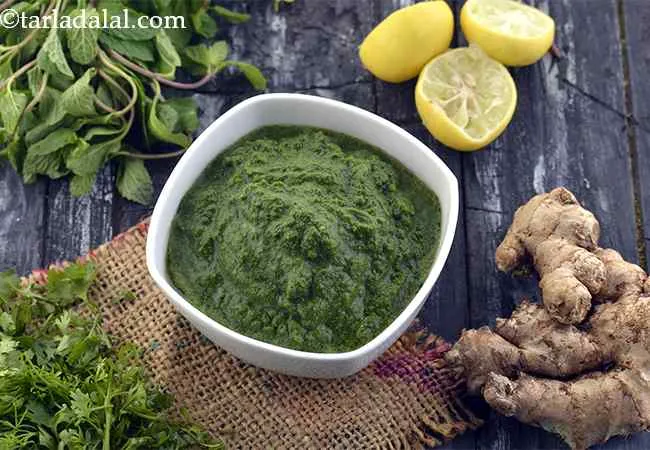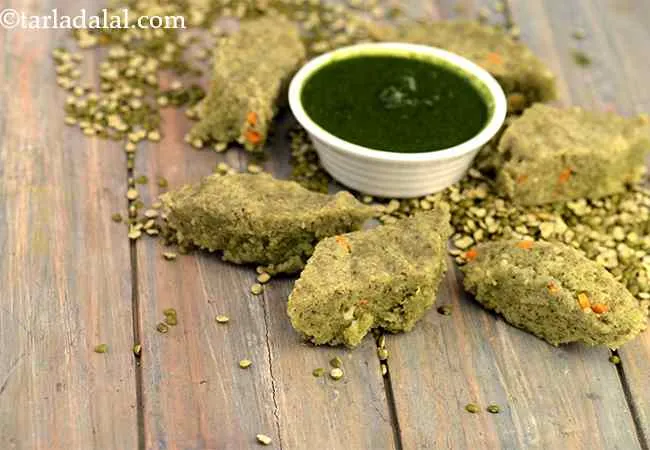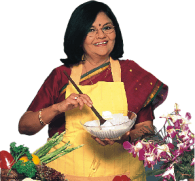Calories in Khatta Dhokla Recipe (White Dhokla)
This calorie page has been viewed 32550 times

How many calories does one piece of Khatta Dhokla have?
One peice of Khatta Dhokla gives 34 calories. Out of which carbohydrates comprise 28 calories, proteins account for 4 calories and remaining calories come from fat which is 3 calories. One Khatta Dhokla provides about 2 percent of the total daily calorie requirement of a standard adult diet of 2,000 calories.
Click here to see khatta dhokla recipe. Khatta dhokla is a famous Gujarati snack loved by all. The ‘khatta’ in the khatta dhokla is the dominant flavour of this traditional khatta dhokla and this sourness is brought about by adding a little sour curds. Gujarati’s also call khatta dhokla as idra.
Gujaratis and khatta dhokla go synonymous. White dhokla are popular steamed cakes made using rice and urad dal. Also, there are hundreds of variation to the dhokla recipe just like idli variations.
white dhokla is a soft and fluffy steamed snack from the Gujarati repertoire. This all-time favourite is enjoyed as a starter, as a tea-time snack, or even for breakfast. Basically, something you can have any time you are hungry! Although dhoklas taste good at room temperature too, serve them hot with green chutney and tea for a classic and complete package! It's served with healthy green chutney.
Green Chutney, How To Make Green Chutney Recipe
Though the process to make khatta dhokla is a little lengthy yet the recipe is super easy. If you want to relish delicious Gujarati khatta dhokla you will have to plan things a day prior. It is important to prepare the batter and leave it for fermentation.
To make the khatta dhokla batter, take khatta dhokla flour which is combination of urad dal and rice. Further, add methi seeds which help in fermenting the batter well and also give it an impeccable aroma. Next, the main ingredient that is the sour curd. Make sure the curd is sour, only then you can derive the flavor of dhokla. Next, add makhan also known as white butter. Pour warm water over makhan so that it melts and blends well with the batter and also makes mixing easier.
Mix using your hands and make sure that the batter is lump-free. Furrther, cover and keep aside in a warm place for fermentation. Once the batter is fermented, add ginger-green chili paste which would enhance the taste of the idra. Further, add oil and baking soda, these two help making the white dhokla soft. Pour little water over baking soda. Make sure you do not mix vigorously as you may neglect the effect of baking soda. Further, pour 1 portion of batter in a greased thali and let it steam for 11-12 minutes. Check by inserting a knife if the khatta dhokla is cooked. Cut into desired shape and serve!!
Although khatta dhoklas taste good at room temperature too, serve them hot with green chutney and tea for a classic and complete package!
Traditionally there is no tempering made for the safed dhokla but, if you like then heat some oil and temper with mustard seeds and curry leaves and add it to the batter before steaming. Alternatively you can also spread this temepeing on the dhokla after steaming.
Is Khatta Dhokla healthy?
Yes and No, depends who is eating it. Khatta dhokla is made from rice, urad dal, sour curds and Indian spices.
Let's understand the ingredients of khatta dhokla.
What's the good in Khatta Dhokla
Urad Dal : 1 cup of cooked urad dal gives 69.30% of folic acid of your daily requirement of folate. The folic acid in urad dal helps your body to produce and maintain new cells, especially red blood cells. Being rich in Phosphorus it works with Calcium to build our bones. See here for 10 super benefits of urad dal.
Curd + Low fat Curds + Sour Curds : Curds help in digestion as it has very good bacteria. Probiotics in curds acts as a mild laxative but, in case of diarrhoea and dysentery, it is a boon, if curd is used with rice.They help in weight reduction, good for your heart and build immunity. The only difference between curds and low fat curds is the fat level. Read the benefits of curds to include in your daily diet.
Fenugreek Seeds (Methi Seeds) : 1 tsp of fenugreek seeds soaked overnight and consumed early in the morning on an empty stomach is a remarkable cure to control blood sugar levels for diabetics. Fenugreek seeds have been known to benefit the heart by way of reducing cholesterol levels in the blood. Fenugreek seeds have long been suggested to enhance breast milk production to lactating mums. A teaspoon of fenugreek seeds swallowed with half glass water is also a very well-known home remedy for diarrhoea. See detailed benefits of fenugreek seeds methi seeds.
Ginger (Adrak) : Ginger is an effective cure for congestion, sore throat, cold and cough. It aids digestion and relieves constipation. Ginger was found as effective as drugs in relieving menstrual pain. Ginger is effective in decreasing the cholesterol levels in patients with high cholesterol. Ginger significantly reduces symptoms of nausea in pregnant ladies. See here for 16 Super Health Benefits of Adrak, Ginger.
Benefits of Black Pepper ( kali mirch) : Black pepper has been identified to stimulate the digestive juices and enzymes in the gut thus lending a helping hand in maintaining digestive health. The antibacterial nature of black pepper helps to relieve cold and cough, especially when black pepper is ground and mixed with honey and consumed. kali mirch may help in maintaining normal blood sugar levels as it improves insulin sensitivity. So diabetics and weight watchers with high blood sugar levels both can benefit from black pepper. Kalimich is known to boost metabolism and promote fat cell breakdown. Yes, the piperine in it may help you overcome obesity, weight loss. See detailed benefits of black pepper, kali mirch.
What's the problem in Khatta Dhokla
Rice : Here are the pros for rice. Rice is a great source of complex carbohydrates, which is an important source of energy for our body. Rice is low in fibre and therefore a good option for people suffering from diarrhoea. What's not good in rice. Foods like rice are high in GI are not suitable for weight loss, heart patients, diabetics as they affect the blood sugar control levels. See details of is white rice and parboiled rice good for you?
Is khatta dhokla good for diabetics, heart and overweight individuals?
The issue of khatta dhokla is that it uses 1.5 cups of rice and only 1/2 cup of urad dal. Hence the carb levels are high. So you may snack on a few pieces at best as this is a steamed Gujarati snack.
moong dal dhokla recipe is a healthier option to have as this has ZERO rice.
Moong Dal Dhokla
Is khatta dhokla safe for healthy individuals?
Yes, khatta dhokla is safe. Khatta dhokla is a fermented food which is easy to digest. Fermentation of foods increases the bioavailability of nutrients which helps the body to assimilate more nutrition. The microorganisms break down the complex protein, carbohydrates and fat efficiently thereby helping to assimilate more nutrients from the food. The bioavailability of proteins and Vitamin B content also increases.
Khatta Dhokla is good for
6. Kids snacks
How to burn 34 calories that come from one piece of Khatta Dhokla?
Walking (6 kmph) = 10 mins
Running (11 kmph) = 3 mins
Cycling (30 kmph) = 5 mins
Swimming (2 kmph) = 6 mins
Note: These values are approximate and calorie burning differs in each individual.
| Value per pieces | % Daily Values | |
| Energy | 550 kcal | 27% |
| Protein | 16.1 g | 27% |
| Carbohydrates | 110.8 g | 40% |
| Fiber | 0.00 g | 0% |
| Fat | 4.29 g | 7% |
| Cholesterol | 2.7 mg | 1% |
| VITAMINS | ||
| Vitamin A | 44.7 mcg | 4% |
| Vitamin B1 (Thiamine) | 0.1 mg | 10% |
| Vitamin B2 (Riboflavin) | 0.2 mg | 11% |
| Vitamin B3 (Niacin) | 30.2 mg | 215% |
| Vitamin C | 0.2 mg | 0% |
| Vitamin E | 0.0 mg | 0% |
| Folic Acid (Vitamin B9) | 0.9 mcg | 0% |
| MINERALS | ||
| Calcium | 95.3 mg | 10% |
| Iron | 0.0 mg | 0% |
| Magnesium | 3.2 mg | 1% |
| Phosphorus | 142.2 mg | 14% |
| Sodium | 3219.9 mg | 161% |
| Potassium | 15.0 mg | 0% |
| Zinc | 0.0 mg | 0% |
Percent Daily Values are based on a 2000 calorie diet. Your daily values may be higher or lower depending on your calorie needs.

Click here to view Khatta Dhokla, Gujarati Recipe
Calories in other related recipes



















